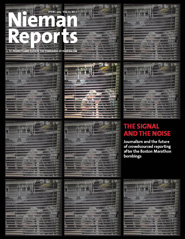In case you missed it, Nieman Reports, one of our sister publications, featured a few pieces recently on poetry and metaphor. The discipline and the device serve narrative’s need for quick-stroke description, evocative imagery and attention to rhythms and cadence — for, ideally, a loveliness of language. Click through for the full run, but here, for your writing files, are some highlights:
In a piece on how Bloomberg Businessweek uses metaphors, economics editor Peter Coy writes that all journalists should try to master metaphor:
If you aren’t making up your own metaphors, you’re probably using someone else’s. Trying to communicate without using any metaphors would be like trying to complete a paint-by-numbers canvas without red, blue, yellow and green. Even professional economists use metaphors. Ben Bernanke coined “fiscal cliff” last year. “Liquidity” is such a common term in technical economics that we forget that money-as-fluid is really another metaphor. John Maynard Keynes used metaphors constantly. He said that trying to increase output by increasing the money supply “is like trying to get fat by buying a larger belt.” He blamed the Great Depression on “magneto trouble”—a faulty alternator under the hood that prevented the car from running.
 Poetry and the news have a lot in common — poet and Harvard English professor Stephen Burt explains the connection:
Poetry and the news have a lot in common — poet and Harvard English professor Stephen Burt explains the connection:
You can have—you can attempt to embody in verse, to compress, to make eloquent—feelings or complicated inward responses, responses that reveal your character, to almost anything: to a twig or a fallen leaf or a sexual overture but also to what we now call headline news. The form of the sonnet, so often associated with erotic love, has become so prominent in English in part because poets use it to react to the news: Milton in the English Civil War, Wordsworth on the fall of the Venetian Republic and the capture of Toussaint L’Overture, several now-forgotten Victorian poets on dispatches from the Crimean War, Gwendolyn Brooks on poverty, race, Chicago, and World War II. Many of the supposed oppositions between poems and news just dissolve on scrutiny: Poetry often reacts to public events; poetry can be pellucid (as in Louise Glück or Christina Rossetti) as well as opaque; and journalists can take on complicated ideas with specialized vocabulary (collateralized mortgage obligations, for example, or mitochondrial DNA).
Combining the two, here’s part of former Nieman Fellow Mike Pride’s interview with the great Donald Hall:
Pride: For many years, you and I drove together down to Lippmann House and spoke with the Nieman Fellows about what a poet could teach journalists about writing. Why don’t we start with one of our favorite subjects, the dead metaphor?
Hall: Absolutely. All winter I read in the Boston Globe and probably in the Monitor about a “blanket of snow.” Isn’t that wonderful? It always annoys me, of course. There are words that are used in the headlines because they are short. But dead metaphors are something I notice all the time. You can kid yourself so easily. I have written a draft of a poem 50 times, 60 times, and see a gross dead metaphor in it. It’s easy enough to do it.
I remember telling a girl over at Cornell one time that I never say “dart” for a person moving quickly because “dart” is English invented in pubs. A dart is an arrow and using that as a verb … it’s like, “I was anchored to the spot” or “I was glued to the spot” means that a ship in a harbor and Elmer’s glue are the same thing. Remember that, and maybe it will help you avoid a dead metaphor.
From a practical standpoint, what you’re really talking about is helping writers pick the more precise word, right?
It is precise, because it’s not something under the surface, another object. It’s looking straight forward. There are people who say that everything in language is originally a metaphor, and I don’t understand the thought, but I don’t deny it. With prose that is full of dead metaphors, no character can get through. Everything has a veil between the utterance of the speaker and the perception of the reader, the listener. Somehow plainness is more intimate than the word “shrouded,” the word “blanketed.” A shroud is a shroud, and that’s fine. A blanket is a blanket. I can write about it, but don’t confuse it with an item that covers.
Give it a try? Scholastic’s Literary Cavalcade blog once asked former poet laureate Ted Kooser for a way to practice metaphor, and he suggested the writing exercise found at the end of this conversation.
Related reading: “Poetry as Narrative Journalism? You’d Be Surprised”


